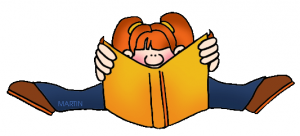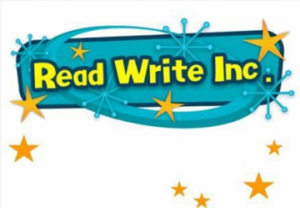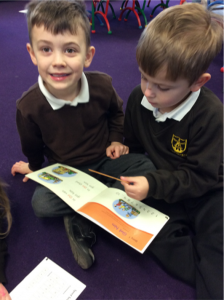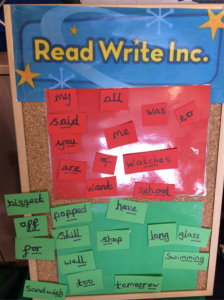

 At Sandhurst Primary School we use the Read Write Inc (RWI) programme to get children off to a flying start with Reading. Read Write Inc Phonics is for children in Reception, Y1 and Y2 who are learning to read. It is also for children in Y3 and Y4 who haven’t met the KS1 reading expectations. Read Write Inc Fresh Start is for children in Years 5 and 6, who may need extra practice to learn to read. We want to make sure they catch up quickly and leave our school a reader. Fresh Start is structured in the same way as the Phonics programme, but uses age-appropriate texts.
At Sandhurst Primary School we use the Read Write Inc (RWI) programme to get children off to a flying start with Reading. Read Write Inc Phonics is for children in Reception, Y1 and Y2 who are learning to read. It is also for children in Y3 and Y4 who haven’t met the KS1 reading expectations. Read Write Inc Fresh Start is for children in Years 5 and 6, who may need extra practice to learn to read. We want to make sure they catch up quickly and leave our school a reader. Fresh Start is structured in the same way as the Phonics programme, but uses age-appropriate texts.
Read Write Inc is a government approved phonic based approach to teaching reading. It involves children learning to read sounds and how to blend them together to read words.
Read Write Inc is a successful reading programme that enables every child to become a confident and fluent reader at the first attempt. It aims to teach all children to read at a pace that they are comfortable with.
In line with the EYFS Development Matters document and the National Curriculum, skilled word reading involves both the speedy working out of the pronunciation of unfamiliar printed words (decoding) and the speedy recognition of familiar printed words. Underpinning both is the understanding that the letters on the page represent the sounds in spoken words. This is why phonics is emphasised in the early teaching of reading to beginners (i.e. unskilled readers) when they start school.
Our daily Phonics lessons in EYFS and KS1 ensure that pupils can sound and blend unfamiliar printed words quickly and accurately using their phonic knowledge and skills . The Read Write Inc programme introduces grapheme-phoneme correspondences (GPCs) and all sounds are revised and consolidated daily.
Alongside this knowledge of GPCs, in our phonics lessons pupils are develop the skill of blending the sounds into words for reading and establish the habit of applying this skill whenever they encounter new words. This is supported by practice in reading books consistent with their developing phonic knowledge and skill and their knowledge of common exception words.
We teach Read Write inc for one hour, daily, as a stand alone lesson in EYFS and KS1.
Pupils are assessed and organised in streamed groups, ensuring every child is working in a group with suitably pitched and challenged sounds and books. Our 6-weekly assessments enable the groups to be fluid so every child can work at their own pace. If a child is not progressing we plan 1:1 tuition sessions which have proven successful, ensuring all pupils progress.
Each phonics session follows the same routines weekly. Practicing and revising graphemes and phonemes, learning revising sight words (red words) reading a book, (decoding , blending and reading sight words) and discussions about the text, and then applying phonic skills into our writing.
Say, “Hello” to Fred. Fred can only talk in sounds...
He says “c_a_t.” not cat. We call this Fred Talk.

| Year Group | Term 1 | Term 2 | Term 3 | Term 4 | Term 5 | Term 6 |
| EYFS |
|
|
|
|
|
|
| Year 1 |
|
|
|
|
|
|
| Year 2 |
|
|||||
| Year 3 & 4 |
|
|||||
| Year 5 & 6 |
|
|||||
How we teach reading – answers for parents
How will my child be taught to read?
We start by teaching phonics to the children in the Reception class. This means that they learn how to ‘read’ the sounds in words and how those sounds can be written down. This is essential for reading, but it also helps children learn to spell well. We teach the children simple ways of remembering these sounds and letters. Ask them to show you what these are.
The children also practise reading (and spelling) what we call ‘tricky words’, such as ‘once,’ ‘have,’ ‘said’ and ‘where’.
The children practise their reading with books that match the phonics and the ‘tricky words’ they know. They start thinking that they can read and this does wonders for their confidence.
The teachers read to the children, too, so the children get to know all sorts of stories, poetry and information books. They learn many more words this way and it also helps their writing.
How will I know how well my child is doing?
We will always let you know how well your child is doing.
We use various ways to find out how the children are getting on in reading. We use the information to decide what reading group they should be in. Your child will work with children who are at the same reading level as him or her. Children will move to a different group if they are making faster progress than the others. Your child will have one-to-one support if we think he or she needs some extra help to keep up.
We also use a reading test so that we can make sure that all our children are at the level that they should be for their age compared to all the children across the country.
In the summer term, the government asks us to do a phonics check of all the Year 1 children. That gives us extra information about their progress. We will talk to you about how well your child has done, and especially if we have any worries at all.
How long will it take to learn to read well?
By the end of Year 2, your child should be able to read aloud books that are at the right level for his or her age. In Year 3 we concentrate more on helping children to understand what they are reading, although this work begins very early on. This happens when the teacher reads to the children and also when the children read their own story book.
How do I know the teaching will be good?
All the staff have been trained to teach reading in the way we do it in this school. We believe that it is very important that all the teachers and teaching assistants work in the same way. Senior teachers watch other teachers teaching to make sure that the children are learning in the way we want them to learn.
What can I do to help? Is there anything that I shouldn't do?
Your child will bring different sorts of books home from school. It helps if you know whether this is a book that your child can read on their own or whether this is a book that you should read to them. The teacher will have explained which is which. Please trust your child’s teacher to choose the book(s) that will help your child the most.
Help your child to sound out the letters in words and then to ‘push’ the sounds together to make a whole word. Try not to refer to the letters by their names. Help your child to focus on the sounds. You can hear how to say the sounds correctly at this link:
ruthmiskin.com/en/find-out-more/parents/#lg=1&slide=2
Sometimes your child might bring home a picture book that they know well. Please don’t say, ‘This is too easy.’ Instead, encourage your child to tell you the story out loud; ask them questions about things that happen or what they think about some of the characters in the story.
We know parents and carers are very busy people. But if you can find time to read to your child as much as possible, it helps him or her to learn about books and stories. They also learn new words and what they mean. Show that you are interested in reading yourself and talk about reading as a family.
What if he or she finds it difficult to learn to read?
We want children to learn to read, however long it takes us to teach them. We will find out very quickly if your child is finding reading difficult. First, we move children to a different group, so that we can make sure that they have learnt what they need to know. If they still struggle, we give them extra time with an adult, on their own. These adults are specially trained to support these children. Your child will still be in the same group with the other children and won’t miss out on any of the class lessons.
If we have any serious worries about your child’s reading, we will talk to you about this.
Some children take a bit longer to learn to put sounds together to read a word, e.g. c-a-t to make the word ‘cat’. At our meeting, we will explain how you can help your child to do this.
What if my child turns out to be dyslexic?
The way we teach reading is especially helpful for children who might be dyslexic. This is because we use a very well-organised programme that has a strong focus on phonics. This is very important for children who find learning to read difficult. If you are worried about your child, please come and talk to us.
My child has difficulty pronouncing some sounds. Will this stop him learning to read through phonics?
This isn’t a problem for learning to read as long as we know what sound the child is trying to say. This is not something to worry about. Many children have a few sounds that they can hear clearly but find it difficult to say, particularly the l-sound, r-sound, w-sound, th-sound, s-sound, sh-sound and j-sound. Often they say a t-sound for the c-sound; "tttssh" for the s-sound; "w" for the r-sound and "r" for the l-sound. You can help your child by encouraging him or her to look at your mouth when you say the sound. Whatever you do, do not make your child feel a failure. They can easily learn to read, even if they find one or two sounds difficult to say.
Don’t hesitate to contact us if you have any concerns. We are here to help.


